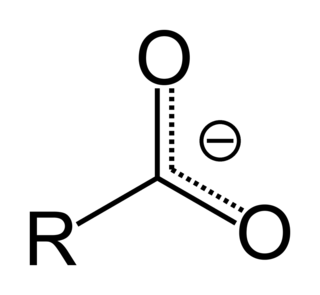The molecular formula C4H7NO2 may refer to:
- (Z)-4-Amino-2-butenoic acid
- 1-Aminocyclopropane-1-carboxylic acid
- Azetidine-2-carboxylic acid
- Diacetyl monoxime
- Acetoacetamide
The molecular formula C4H7NO2 may refer to:

In organic chemistry, a carboxylic acid is an organic acid that contains a carboxyl group attached to an R-group. The general formula of a carboxylic acid is R−COOH or R−CO2H, with R referring to the alkyl, alkenyl, aryl, or other group. Carboxylic acids occur widely. Important examples include the amino acids and fatty acids. Deprotonation of a carboxylic acid gives a carboxylate anion.

In chemistry, an ester is a compound derived from an acid in which the hydrogen atom (H) of at least one acidic hydroxyl group of that acid is replaced by an organyl group. Analogues derived from oxygen replaced by other chalcogens belong to the ester category as well. According to some authors, organyl derivatives of acidic hydrogen of other acids are esters as well, but not according to the IUPAC.
Chromic acid is an inorganic acid composed of the elements chromium, oxygen, and hydrogen. It is a dark, purplish red, odorless, sand-like solid powder. When dissolved in water, it is a strong acid. There are 2 types of chromic acid, they are: molecular chromic acid with the formula H
2CrO
4 and dichromic acid with the formula H
2Cr
2O
7.

In organic chemistry, a carboxylate is the conjugate base of a carboxylic acid, RCOO−. It is an ion with negative charge.

Pimelic acid is the organic compound with the formula HO2C(CH2)5CO2H. Pimelic acid is one CH
2 unit longer than a related dicarboxylic acid, adipic acid, a precursor to many polyesters and polyamides. However compared to adipic acid, pimelic acid is relatively small in importance industrially. Derivatives of pimelic acid are involved in the biosynthesis of the amino acid lysine and the vitamin biotin.
Asparagusic acid is an organosulfur compound with the molecular formula C4H6O2S2 and systematically named 1,2-dithiolane-4-carboxylic acid. The molecule consists of a heterocyclic disulfide functional group (a 1,2-dithiolane) with a carboxylic acid side chain. It is found in asparagus and is believed to be the metabolic precursor to odorous sulfur compounds responsible for the distinctive smell of urine which has long been associated with eating asparagus.
The molecular formula C5H9NO2 (molar mass : 115.13 g/mol) may refer to:

Naphthenic acid (NA) is a mixture of several cyclopentyl and cyclohexyl carboxylic acids with molecular weight of 120 to well over 700 atomic mass units. The main fraction are carboxylic acids with a carbon backbone of 9 to 20 carbons. McKee et al. claim that "naphthenic acids (NAs) are primarily cycloaliphatic carboxylic acids with 10 to 16 carbons"[1], although acids containing up to 50 carbons have been identified in heavy petroleum. The term naphthenic acid has roots in the somewhat archaic term "naphthene" used to classify hydrocarbons. It was originally used to describe the complex mixture of petroleum-based acids when the analytical methods available in the early 1900s could identify only a few naphthene-type components with accuracy. Today "naphthenic" acid is used in a more generic sense to refer to all of the carboxylic acids present in petroleum, whether cyclic, acyclic, or aromatic compounds, and carboxylic acids containing heteroatoms such as N and S. Although commercial naphthenic acids often contain a majority of cycloaliphatic acids, multiple studies have shown they also contain straight chain and branched aliphatic acids and aromatic acids; some naphthenic acids contain >50% combined aliphatic and aromatic acids.
The molecular formula C4H4O2 may refer to:

Azetidine-2-carboxylic acid (abbreviated Aze or Azc) is a plant non-protein amino acid homologue of proline with the molecular formula C4H7NO2. Aze is a heterocyclic, 4 membered ring with nitrogen as its heteroatom (an azetidine), and a carboxylic acid group substituted on one of the ring carbon atoms. The main difference between Aze and proline is the ring of Aze has four members and the ring of proline has five. Aze has the ability to act as an analog of proline and can be incorporated into proteins in place of proline.
The molecular formula C2H3ClO2 may refer to:
The molecular formula C5H7NO2 may refer to:
The molecular formula C15H20O4 may refer to:
The molecular formula C25H22O10 may refer to:
The molecular formula C7H6O5 (molar mass: 170.12 g/mol, exact mass: 170.021523 u) may refer to:

Diphenolic acid is a carboxylic acid with molecular formula C17H18O4. Its IUPAC name is 4,4-bis(4-hydroxyphenyl)pentanoic acid, and it can be prepared by the condensation reaction of phenol with levulinic acid in the presence of hydrochloric acid. The equation for this synthesis is:
In organic chemistry, thiocarboxylic acids or carbothioic acids are organosulfur compounds related to carboxylic acids by replacement of one of the oxygen atoms with a sulfur atom. Two tautomers are possible: a thione form and a thiol form. These are sometimes also referred to as "carbothioic O-acid" and "carbothioic S-acid" respectively. Of these the thiol form is most common.

2-Bromobutyric acid is a carboxylic acid with the molecular formula C4H7BrO2. It is a colorless liquid. The 2-position is stereogenic, so there are two enantiomers of this compound. 2-Bromobutyric acid is mainly used as a building block chemical, such as in the preparation of Levetiracetam, an anticonvulsant medication.

Pyromellitic dianhydride (PMDA) is an organic compound with the formula C6H2(C2O3)2. It is the double carboxylic acid anhydride that is used in the preparation of polyimide polymers such as Kapton. It is a white, hygroscopic solid. It forms a hydrate.
Benzoin may refer to: